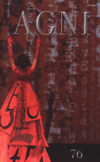AGNI – Number 76
You know you should have bought a subscription to a magazine when you learn, one issue too late, that the editors were going to host a retrospective on Robert Lowell (AGNI 75). Or when, casually perusing the issue at hand, you discover apparitions of Ray Bradbury (see David Huddle’s piece), Cynthia Ozick (see Tamas Dobozy channel Harper’s The Bloodline of the Alkanas), and Allegra Goodman (see Wendy Rawlings’s ending channeling La Vita Nuova). The perceptible echo from these influences emerges from talented writers in their own right. And that’s just the fiction.
You know you should have bought a subscription to a magazine when you learn, one issue too late, that the editors were going to host a retrospective on Robert Lowell (AGNI 75). Or when, casually perusing the issue at hand, you discover apparitions of Ray Bradbury (see David Huddle’s piece), Cynthia Ozick (see Tamas Dobozy channel Harper’s The Bloodline of the Alkanas), and Allegra Goodman (see Wendy Rawlings’s ending channeling La Vita Nuova). The perceptible echo from these influences emerges from talented writers in their own right. And that’s just the fiction.
This issue of Agni is exceptionally well curated, which is why I draw the parallels above. Huddle’s “The Future” is as unforgettable as certain Bradbury stories because its futurism enables one to consider tough ethical questions when the variables are already in so many ways controlled by the author—not by assumptions of actuality. Huddle’s story, which functions as acerbic social commentary using an imaginative assassination ploy, completely upset my expectations. In fact, the story is tightly paced enough to begin with the invitation to choose. Per the narrator’s friend, an apparently brilliant woman with a slew of degrees from the most competitive graduate schools, the narrator can choose anyone in the world to be eliminated, and that person will die instantly with no trace of the identity of the executioner. After deliberation and some fuel to the plot, he selects [Supreme Court Justice Anton] Scalia. My chin bobbed upon hearing his decision.
However, in the story’s denouement, the narrator, having made his choice, retreats to the ‘safety’ of National Public Radio. His concluding statement is: “Terry Gross always makes me feel like the world is still an okay place to live.” The statement emphasizes “live,” such a binary opposition to the central act in the story, but it also plays with the idea that Gross and NPR can be just as mesmerizing as other kinds of propaganda. What I learned from this story strictly as a reader was that one should not be swayed by the preposterousness of the proposition. Even in fiction, even in futurism, maybe even in stand-up comedy, there are certain things one doesn’t take lightly. Sure, Huddle minimizes the apparent consequences—the individual selected would disappear without pain and without attribution. There is no violence, no element of an individual performing the murder—it is a decision to enable some grand machine to affect it, a kind of distant slaughter by the smartphone. It’s so well done that you have to catch yourself. To my initial response, I would ask if my politics were so polarized that I could even entertain such an outcome. The reasonable American wouldn’t want someone to disappear without due process. Even Scalia.
This proclivity of invention is exemplified in the poetry. Take Sydney Lea’s poem “When the Light Fails” and Eamon Grennan’s poem “Silence.” Both create, in a mechanical sense, a completely separate framework from what one might expect from a literary journal. Lea and Grennan stretch the parameters of the poetic line—the words glide off into a literary sunset of an inverted page. It seems as though these poets will not be silenced or truncated but rather will “Bring on more life!” as Grennan frames his conclusion. AGNI doesn’t crop the longer lines; these poems are free to unfold horizontally. Form matters. Look what happened when Dylan went electric.
Askold Melnyczuk’s “Shadowboxing: Occupational Hazards” considers form and order from within governance. If the astonishing “The Mozart of the Talmud” (Jeffrey Mehlman) can echo the evocative language of Benjamin Cardozo, then Melnyczuk crosses platforms in his own symphony, with subject focus ranging from the Occupy movement to censorship in its multifarious forms. He ropes in Hell-Raiser and Albert Camus and demands in certain, concise terms, for governmental transparency. His catalog of authorities is convincing; his arguments sturdy. What makes the piece especially effective is its inclusion in the magazine at all—the pace of topics on a given editorial calendar of a journal is generally expected to be glacial, but whenever Melnyczuk had penned this editorial was irrelevant because it remains true as to the writing of this review.
As to its own transparency, the AGNI website is a good compliment to the journal. It presents compelling information and broadens the channel of the print magazine, while at the same time respects the intellectual property of the venture by controlling access to the content. If more publications allowed readers to signal with their pocketbooks their support of the written word, more publications would survive. I want to see the translations, innovations and reportage rewarded, and I believe that AGNI’s approach is an excellent method for meeting that goal. And it’s a balanced value proposition—the range of voices is international and intergenerational and Paul Elie’s question in the December 2012 The New York Times Book Review: “Has Fiction Lost Its Faith?” finds an address in these pages.
[www.bu.edu/agni]





